Honey Caramels
So far I’ve posted lots of wholesome (sort of), savory (mostly), meal-type recipes for your reading & eating enjoyment.
It’s time for something truly unnecessary, but totally worth your time.
Homemade candy!
Too difficult, you say? Surely must be… handmade candy is wildly expensive, so it must be a complicated, time-consuming challenge that only fabulous cooks can achieve after years of training, right?
Not so.
Here’s the secret that gourmet candy companies don’t want you to know: many candies are deceptively easy to make. Really. A big pot, a wooden spoon, and a candy thermometer (you can find one for less than twenty bucks at a home goods store, maybe even your grocery store’s baking aisle) comprise the bulk of the equipment list.
Of course, you’ll need some ingredients. Candy with no ingredients would be, well, gross.

Of late, I’ve become somewhat obsessed with integrating honey into my cooking. In my continuing quest to eliminate non-local foods from my diet, white sugar is going to be a major challenge. It makes an appearance on the ingredient list of almost any recipe, but it only grows in like, three US states. (Is that redundant, US states? Please advise.) Anyway, unless I plan to move to Florida, Hawaii, or Louisiana, the odds of finding sugar cane at my local farmers market are slim at best. Honey, on the other hand, is fashioned by busy little bees all over the place.
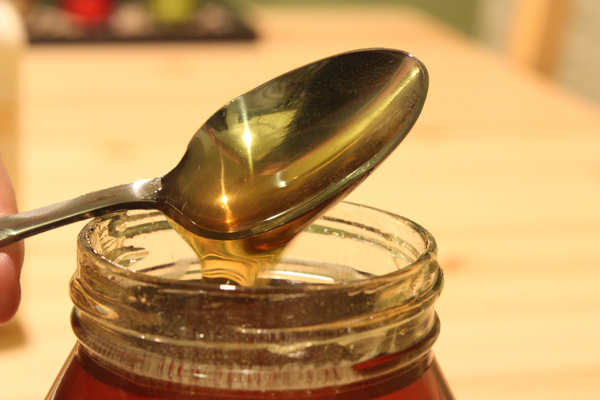 Unfortunately, one cannot simply swap honey for white sugar in many recipes and produce the same result. I learned that lesson in one of the variations of last month’s strawberry jam, and I admit, it was a bit disheartening.
Unfortunately, one cannot simply swap honey for white sugar in many recipes and produce the same result. I learned that lesson in one of the variations of last month’s strawberry jam, and I admit, it was a bit disheartening.
My good friend Sierra (whose family keeps a few hives that produce fabulous honey) put it right: contrary to white sugar, honey tastes dramatically different from season to season, year to year, and hive to hive depending on which kinds of flowers are providing the bees with nectar. This variety is not a bad thing, but it does make honey a less predictable ingredient than ever-steady, ever-reliable white sugar.
This particular caramel contains both honey and white sugar. Figures. Here, the flowery-ness (a word) the honey provides is not a consequence but is, in fact, the key to the bright, old-fashioned, slightly floral flavor that differentiates this caramel from a bag of Milk Maids.
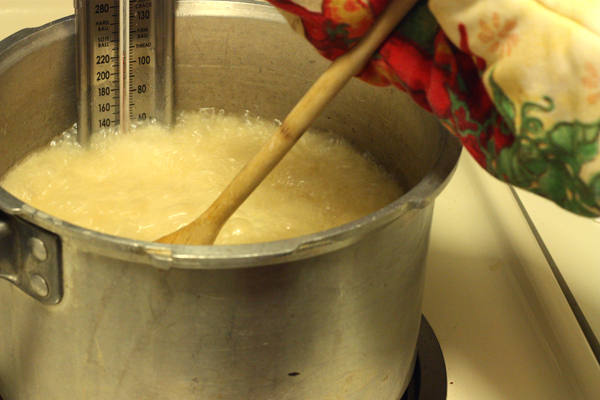
Now there is no reason that the omg-candy-is-an-elusive-domestic-art-totally-beyond-my-skill-level mentality should make its way into your brain while you’re making this treat. But you should stay focused on the task at hand. Like many candies, this process requires a brief but vigorous period of stirring once the caramel comes to a boil, and during that time you pretty much have to ignore your phone, the doorbell, your cat, your boyfriend, any any other noise-makers trying to get your attention.
I won’t lie… boiling caramel is hot. Really hot. It can and will jump out of the pot like lava balls on a mission. Wear closed toe shoes and an oven mitt. Your appendages will thank you.
After this brief period of arm-toning stirring, straight into the pan the candy must go. Then you wait…
…Tick tock…
… for a few hours while the caramel cools. You can also let it cool overnight – just cover the pan so any critters wanted or unwanted don’t give themselves a sugar high.
It will be sticky. I got almost all of mine out the pan. Almost. I consider this wildly successful.
From there, it’s a simple matter of chopping and wrapping your sheet of caramel into bite-sized pieces. Be prepared… you’ll have a lot. This batch made almost 100 caramels! You can wrap them in waxed paper, of course, but I suggest colorful little foil wrappers (I found them at the craft store) to dress things up and show off your little gems.
Your friends will be impressed, your sugar craving satisfied, and you can smile and pretend you slaved over your stove for hours and are privy to some secret, uber-complicated recipes that mere mortals could never dream of completing…
Not really. Don’t be a meanie. If you can’t say something nice, shove a caramel in your mouth to stick your teeth together.
Honey Caramels
Adapted from Old Favorite Honey Recipes
Makes about 100 individually wrapped caramels
A note on candy temperatures: I’ve only recently begun using a candy thermometer. I first learned the water ball method to determine when candy was ready. If you prefer this method, the caramels should reach hard ball stage. If you’re new to candy-making, I recommend a candy thermometer. They are relatively inexpensive and remove the pressure of attempting to scoop boiling candy out of the pot and determining its consistency in cool water.
1 1/2 c whipping cream
2 c white sugar
1 c honey
1/2 tsp vanilla extract
Heavily grease a 9″x13″ cake pan and set near the stove on hot pads. If you have a candy thermometer, attach it to a large pot (no smaller than 3 quarts.) Combine cream, sugar, and honey in the pot over medium-high heat. Stir steadily until ingredients are thoroughly combined. Once mixture begins to boil, stir constantly until candy reaches 260 ºF (hard ball stage.) Add vanilla. Remove from heat and pour immediately into the greased cake pan. Allow pan to cool completely, meaning the top of the caramel and the bottom of the cake pan should reach room temperature.
Once caramels have cooled, turn caramels out onto a cutting board. This might require a little… encouragement with a spatula or knife. Slice caramels into 1″ squares and wrap with wax paper or foil wrappers. Keep in a cool place. Or try to, they’ll disappear quickly.

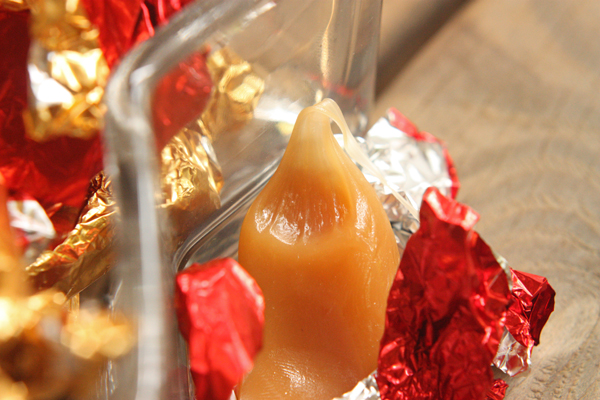
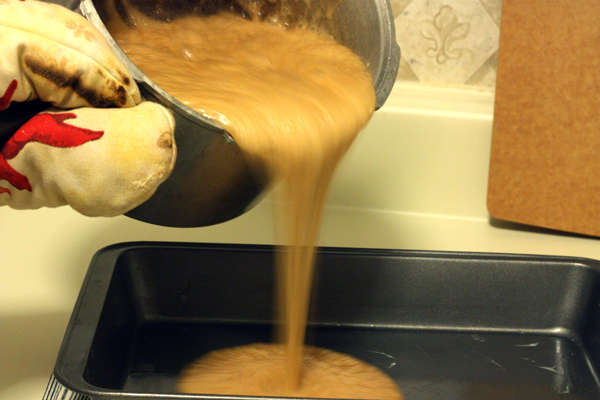
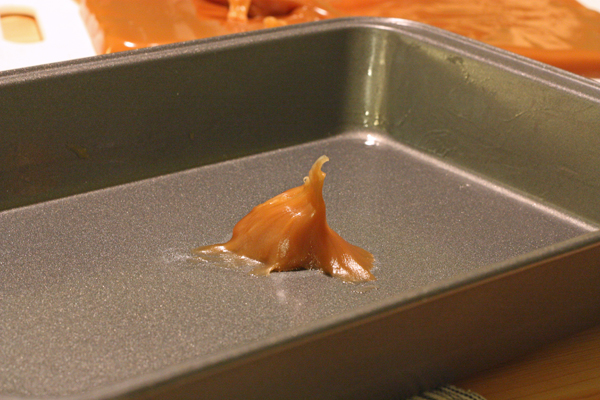
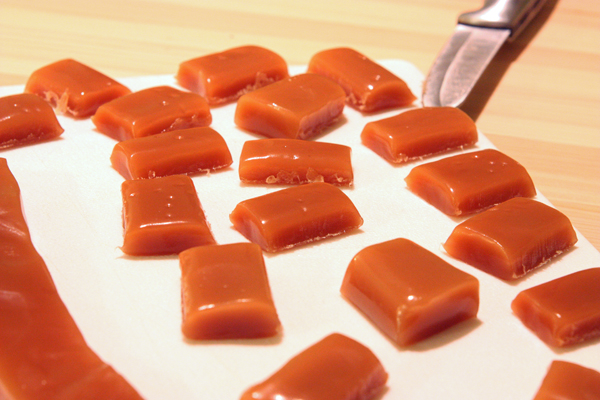
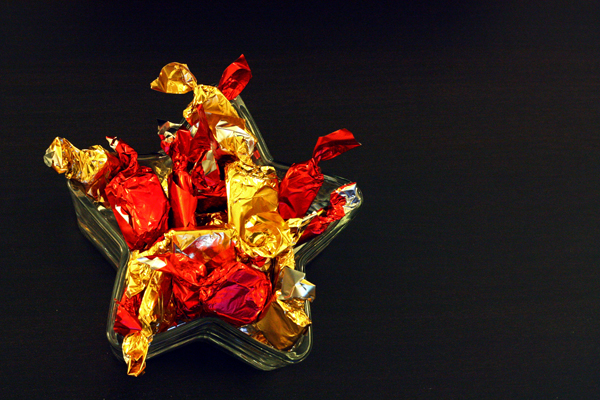
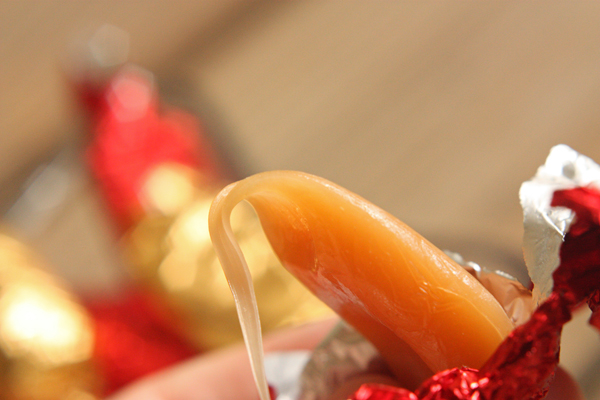
Sierra
June 27, 2011 @ 5:26 pm
ZOMG I’m going to be famous!
Suzy
July 4, 2011 @ 2:03 pm
Well, I just ate the last of my samples, sent by blogmaster Kristi, and they are delicious! I make toffee but have never tried caramels, and I LOVE caramels! What’s with that????? I am going to try these (and maybe put in a pinch of salt!)
Natalie
February 6, 2012 @ 5:29 pm
I made these last night and they tasted fantastic! The only problem I had was cutting them. I made sure they were totally cool, and I think that was the problem. Cooling them made them hard, and I had a heck of a time getting a knife through them. What do you recommend? Not cooling them so much? Thanks in advance.
-Natalie
Kristi @ 30 Pounds of Apples
February 6, 2012 @ 10:10 pm
Well, I think it was quite a work out for me, too. It’s possible that the candy got just a couple of degrees too hot and was too firm?
Kate
October 2, 2012 @ 11:02 pm
I tried making my first batch of caramels and LOVED them! I will certainly be making more! Unlike all the clever people in the world, I lined my pan with wax paper, not parchment paper as stated in my recipe. Just in case it helps anyone else, a hair dryer is a great way to partially melt/re-soften caramels to get them off paper — perhaps that would also help get them out of a pan they are stuck in?